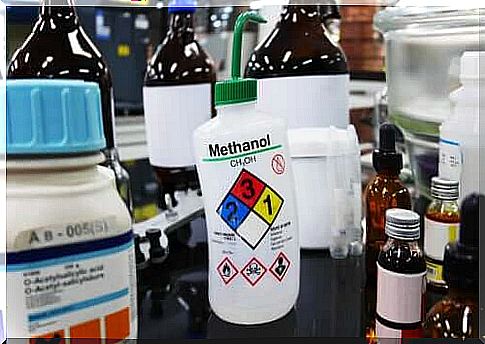Methanol Poisoning – Everything You Need To Know About It

Methanol poisoning is a very real problem. Methanol is a type of alcohol that is colorless and volatile at room temperature. It is also known as wood alcohol or combustion alcohol. It is widely used in industry, laboratories and in the home as it can be found in many cleaners, antifreeze fluids, paints and varnishes.
Methanol poisoning may occur accidentally when handling these products through the respiratory tract. However, in many countries, the most common mode of intoxication is voluntary in the event of suicide. In addition, there is a fraudulent use of this substance as a substitute for ethanol in covertly produced alcoholic beverages.
Methanol poisoning is very rare. However, it has a high fatality rate, ranging from 26 to 50%. On the other hand, in cases where it does not cause death, it leaves behind many neurological and visual sequelae, including blindness.
Therefore, in this article, we will tell you everything you need to know about methanol poisoning, its symptoms and what to do in case of methanol poisoning.
Methanol poisoning – what is methanol?
As we said, methanol is a colorless, volatile, flammable and non-consumable type of alcohol. It is toxic to our body, unlike ethanol, which is found in alcoholic beverages. We can get it from wood distillation, although it can also be synthesized from carbon monoxide or methane.
Some of the products in which it is found:
- Antifreeze for windshield washer fluid lines and natural gas lines.
- Solvents that are used in industry to produce inks, resins, adhesives and dyes. Also a solvent for the production of cholesterol drugs, antibiotics, vitamins and hormones.
- Fuel for energy production.
- Methanol is naturally present in many foods, such as fruits and vegetables. It helps to regulate human genetic activity and facilitates food metabolism. However, the doses in these products are very small and non-toxic.
- Methanol is used to denature ethanol. It prevents the consumption of ethanol-containing products such as mouthwashes and fuel mixtures.
- Methanol can be produced during the production of alcoholic beverages or distillation. Methanol is below toxic doses in permitted alcoholic beverages, but this is not the case for illegally produced beverages.
- Aspartame is an artificial sweetener that, when digested in the body, turns into phenylalanine, aspartic acid, and methanol. However, the amounts produced by digesting aspartame are lower than those produced by fruits and vegetables.
The dose at which methanol becomes toxic is 100 mg / kg, which corresponds to approximately 30 milliliters of pure methanol. The toxic blood level ranges from 0.2 g / L upwards. Some foods contain methanol. However, they are far from reaching the toxic dose.

Why is methanol so dangerous?
When we consume methanol, the intestines absorb it and it reaches the blood. Methanol itself is not toxic, although it can negatively affect the nervous system, causing dizziness or drowsiness. The problem comes when the liver breaks down methanol into formic acid, which is a very toxic substance.
How does formic acid work in our body?
Our blood has an acidity or pH level that must be kept constant for the cells in our body to function well. The range of this acidity must be around 7.35-7.45. If it is less than 7.35, the pH is low, which means the blood is more acidic than normal.
So, if we have formic acid in our blood, the pH drops, causing cells to stop functioning properly and to die. This process is called metabolic acidosis and, if left untreated, can be fatal.
What are the symptoms?
Methanol poisoning begins within 40 minutes to 72 hours, although symptoms usually appear within the first 12-24 hours. Before that time, however, a person may already become intoxicated with methanol.

Symptoms and signs of poisoning may be as follows:
- Central Nervous System: In mild to moderate intoxication, you experience headache, dizziness, lethargy, incoordination, or simply a state of intoxication similar to ethyl intoxication. However, in severe cases, seizures, coma and cerebral edema may occur.
- Eyes : Changes in vision occur which appear as blurred vision, photophobia, and dilation of the pupils. Loss of vision and irreversible blindness due to optic nerve atrophy can also occur as a result of the direct toxic effects of formic acid on the eyes.
- Digestive system : Due to the irritating effect, nausea, vomiting and abdominal pain occur. However, if left untreated, poisoning can affect the pancreas, causing inflammation, and the liver.
- Other Symptoms : To compensate for the acidity of the blood, the body tries to eliminate the acids by excreting CO2, which produces acid products. In other words, the body starts to breathe very quickly and there is shortness of breath.
Methanol poisoning – what can I do?
If you think you have swallowed or inhaled methanol, you should go to the emergency room immediately. The same is true if a family member or friend has taken methanol to hurt themselves. In the hospital, if no more than two or three hours have passed since ingestion, doctors may perform gastric lavage to prevent methanol from being absorbed and aggravating intoxication.
However, we may not be aware that we have methanol poisoning. This is because methanol has no symptoms for a day or two. While you will need to go to the emergency room right away in these situations, you will no longer need gastric lavage, but other procedures:
- General measures : Stabilize the sick person by administering bicarbonate to increase pH and reduce acidity, hydration and support breathing, folinic acid (to avoid eye-threatening effects), and vitamins.
- Avoid converting methanol to formic acid in the liver : Ethanol uses the same enzyme as methanol to be metabolized in the liver and has much higher linkages. Therefore, to prevent methanol from using this enzyme and producing formic acid, doctors inject ethanol. Doctors can also use a drug called Fomepizole to block the action of this enzyme, but it is hard to come by and extremely expensive.
- Hemodialysis : cleans the patient’s blood of both methanol and formic acid.
The doctor must perform these procedures quickly to avoid consequences, especially blindness, and in more advanced cases, the death of a poisoned person.









